Ways to improve the system of work of a speech therapist in the context of the introduction of FGOS to. "The organization of the work of a speech therapist in the conditions of the introduction of FGOS before
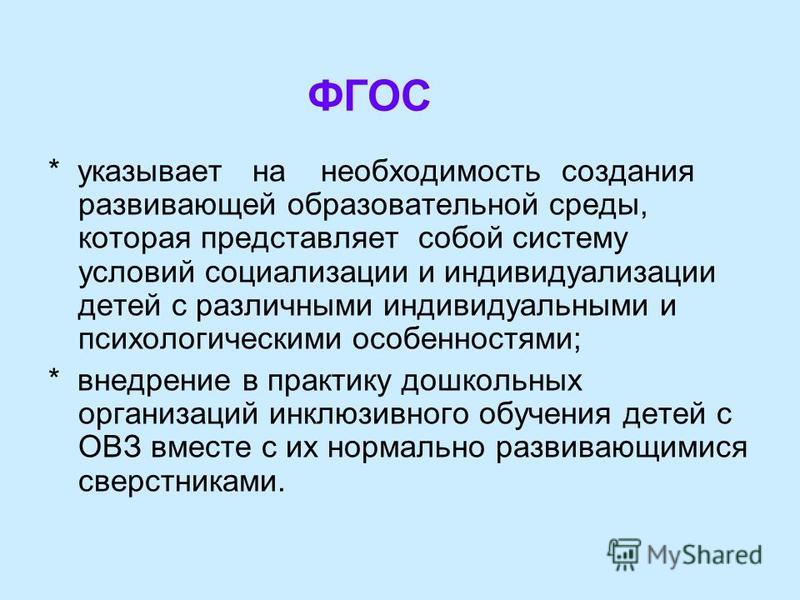
CHILDREN WITH DEVELOPMENTAL DISABLE OHR 52% FNR 24% THR 18% hearing impairment 3% FNR 3%
Federal State Educational Standard * indicates the need to create a developing educational environment, which is a system of conditions for socialization and individualization of children with different individual and psychological characteristics; * implementation into practice preschool organizations inclusive education of children with disabilities together with their normally developing peers.

INCLUSIVE LEARNING organization of the learning process in which all children with certain developmental features (physical, mental, intellectual, etc.) are included in common system education and study at the place of residence together with their healthy peers in the same educational institutions general types that take into account their educational needs and provide their students with special support.
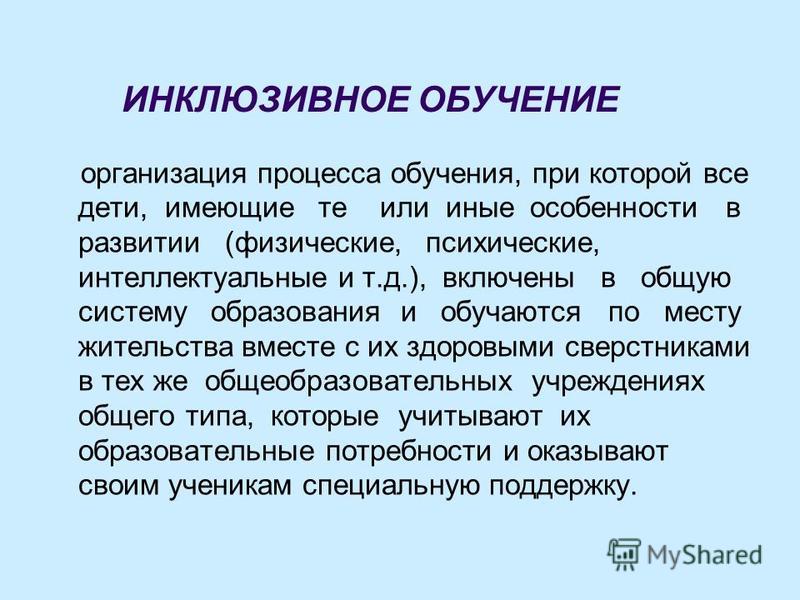
CHILDREN WITH DISABILITIES are children whose health condition prevents them from mastering all or some sections of the preschool educational institution program outside the specially created conditions for upbringing and education. CHILDREN OF THE “RISK GROUP” are children with minimal and partial disabilities who occupy an intermediate position between “normal” and “impaired” development.

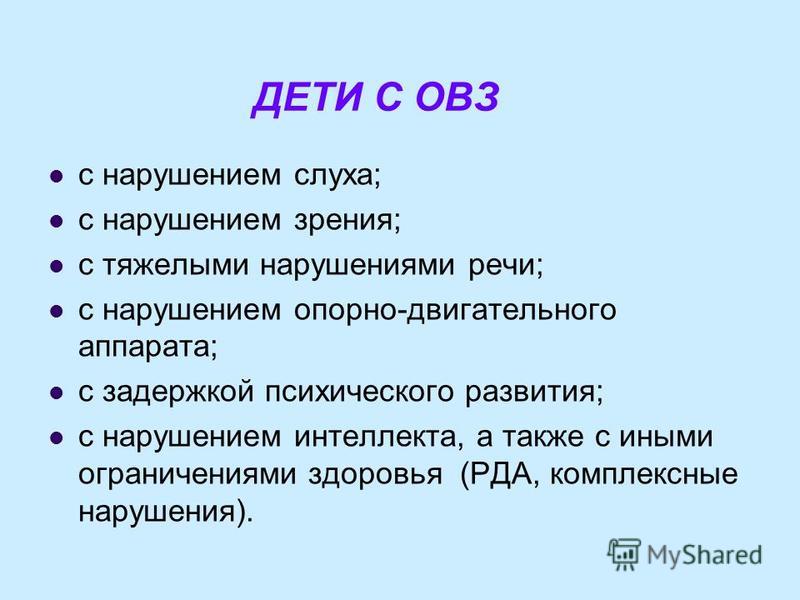
CHILDREN of "RISK GROUP" with minimal hearing impairment; with minimal visual impairment (including strabismus and amblyopia); with speech disorders (dyslalia, st.f. dysarthria, closed rhinolalia, dysphonia, stuttering, violations of the lexical and grammatical structure, violations of phonemic perception; polternum, tachyllalia, bradilalia) pedagogically neglected children; with a slight delay mental development(constitutional, somatogenic, psychogenic);
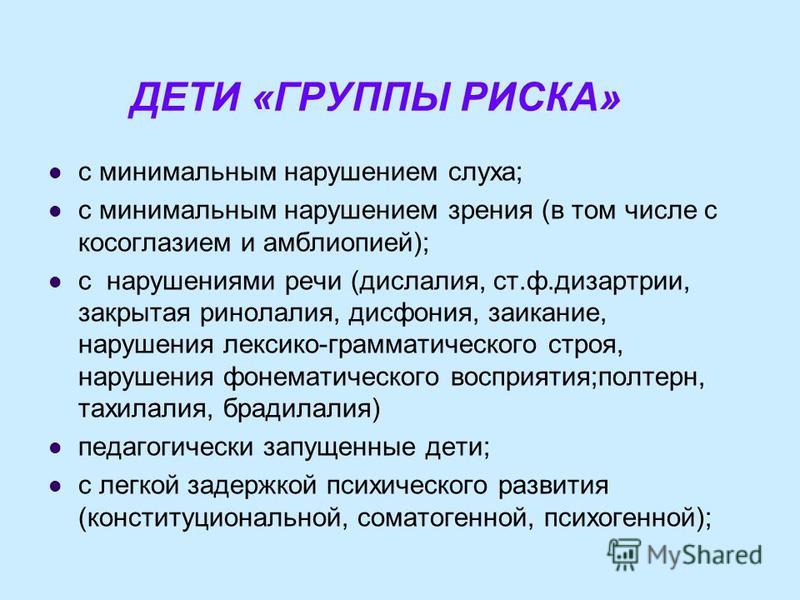
Children-carriers of negative mental states (fatigue, anxiety) of somatogenic or cerebral-organic nature without disturbances intellectual development(frequently ill children, allergy sufferers, with compensated and subcompensated hydrocephalus); children with psychopathic forms of behavior (hysteroid, psychasthenia, etc.); children with impaired forms of behavior of organic genesis (hyperactivity, attention deficit disorder); children with neuroses; children with initial manifestations of mental illness (schizophrenia, autism, epilepsy); children with mild manifestations of motor pathology of a cerebral-organic nature; children with minimal brain dysfunction.

CHILDREN WITH DISABILITIES IN A GENERAL EDUCATIONAL KIND; children with phonetic speech impairment (dyslalia, st.f.dysarthria); children with phonetic-phonemic speech impairment (dyslalia, st.f.dysarthria); children with general speech underdevelopment (motor alalia, dysarthria); children with OHP with mental retardation;
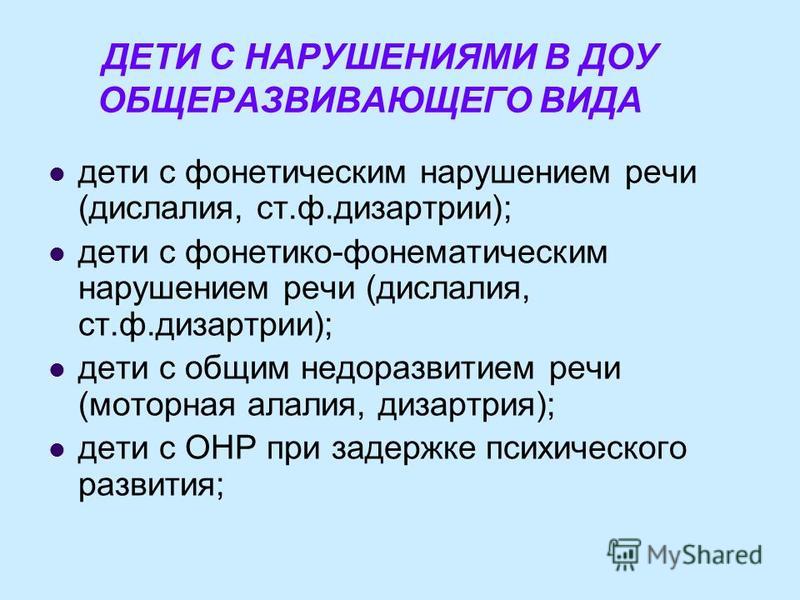
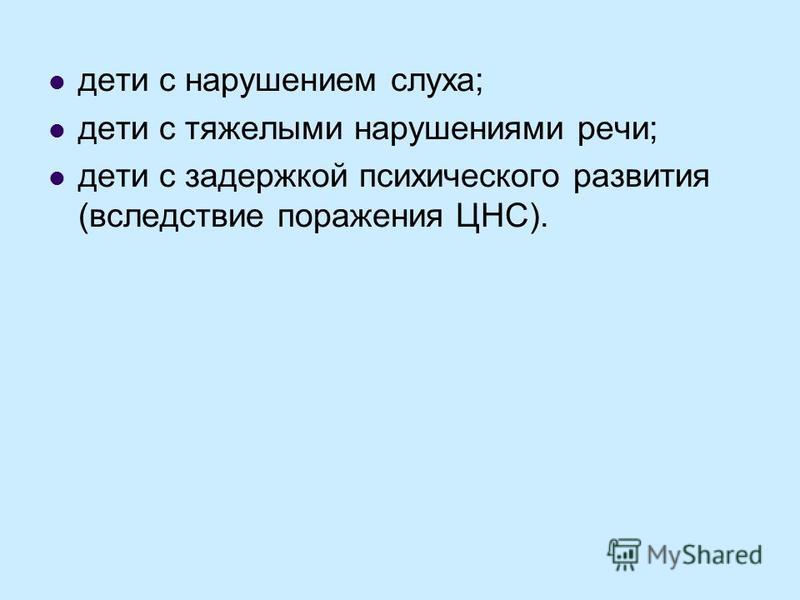
FORMS OF EDUCATION FOR CHILDREN WITH OVZ Group combined focus(joint education of healthy children and children with disabilities); Additional structural units (center for game development support, counseling center, lekoteka, early assistance service, short-term stay group "Special child"), whose activities are aimed at providing educational services families of children with disabilities aged 2 months. up to 7 years.

ALGORITHM FOR DETECTING CHILDREN WITH DISABLES At the beginning school year diagnostic work is carried out to identify children with disabilities and children of the "risk group" (teachers and specialists of preschool educational institutions). Conducting a meeting of the PMPK (council) of the preschool educational institution, where a decision is made to send children with developmental problems to the PMPK (commission). Based on the results of the examination at the PMPK, recommendations are given on the creation of special educational environment... Based PMPK recommendations PMPK specialists educational organization develop individual educational routes and (or) adapted educational programs. Implementation by specialists and teachers of the educational organization individual routes and / or adapted programs.
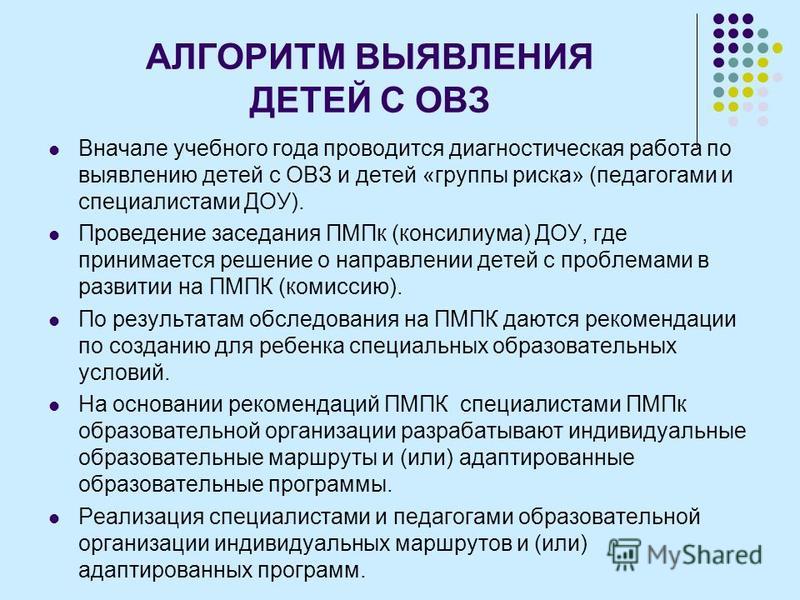

LOGOPEDIC LESSONS individual lessons on sound pronunciation correction and syllabic structure the words; subgroup lessons on the development of the phonetic-phonemic side of speech; subgroup lessons with children on the development of lexical and grammatical categories and coherent speech.
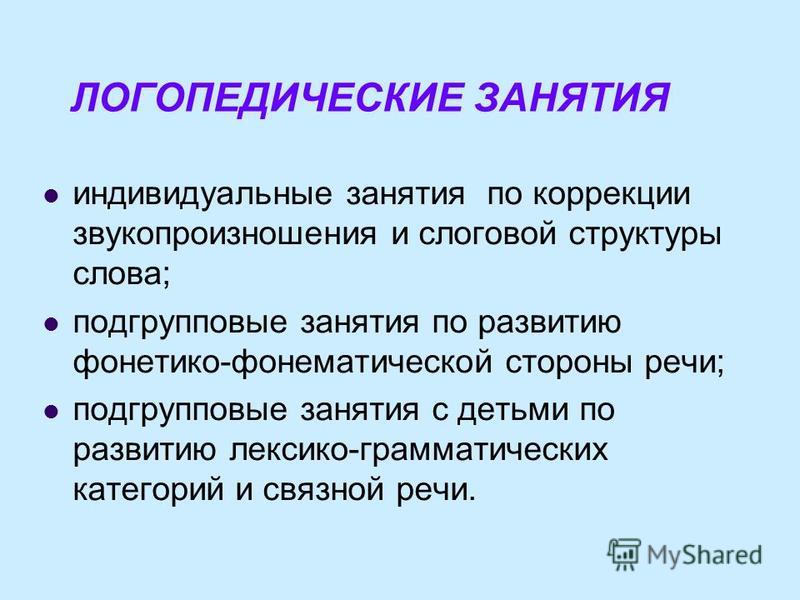
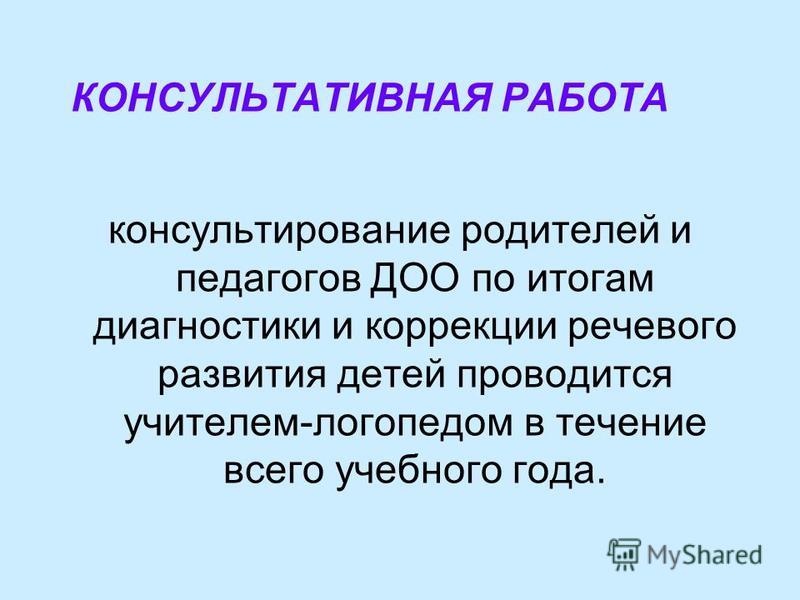
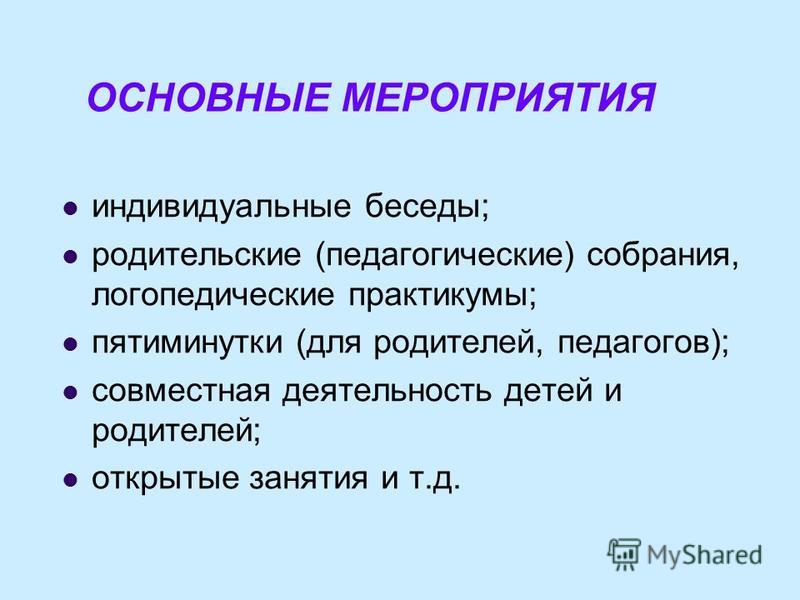
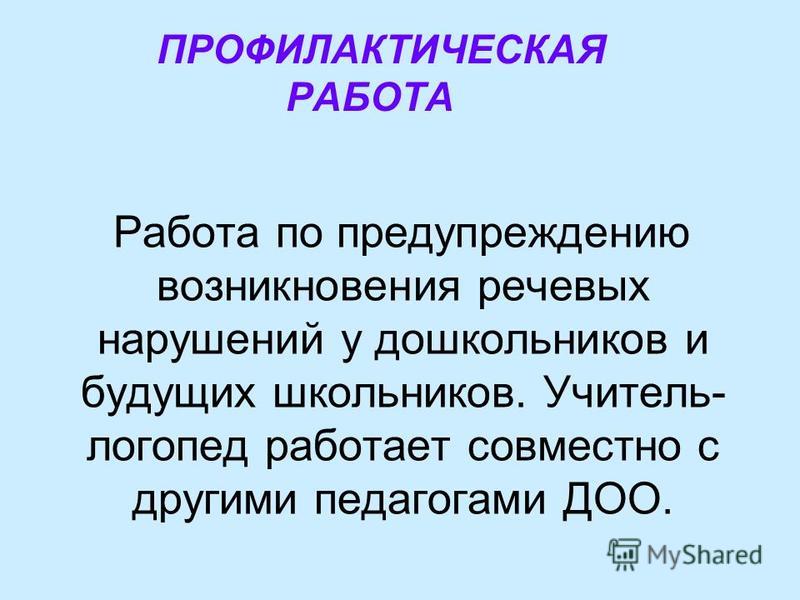

THE ROLE OF RELATIONSHIP OF THE LOGO TEACHER WITH TEACHERS AND PARENTS efficiency correctional work with kids; decrease in the percentage of occurrence of speech disorders in children preschool age; decrease in the percentage of secondary speech disorders in schoolchildren.
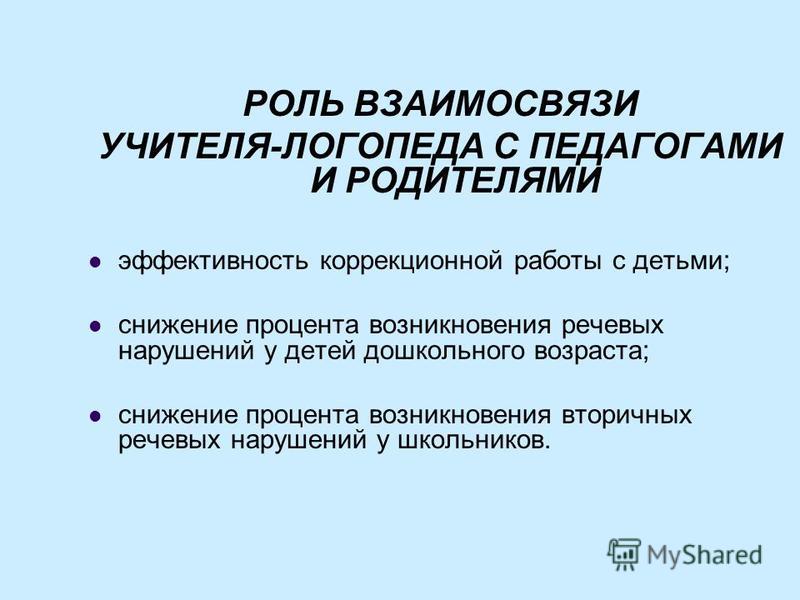
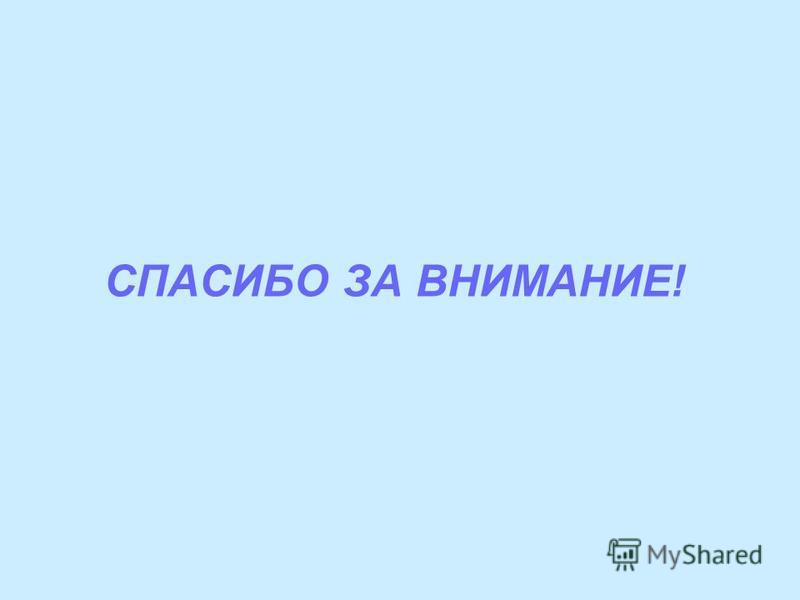
Improvement of the monitoring system; -construction of educational programs; - skillful selection and application of learning technologies; -organization of a subject-developing environment; usage different forms activities; - close cooperation of teachers with parents; -increasing the professional competencies of teachers; -coordination of the work of all specialists of the preschool educational institution
GBDOU kindergarten number 33 Primorsky district
St. Petersburg
Ways to improve the system of work of a speech therapist
in the context of the introduction of the Federal State Educational Standard of DO.
The search for ways to improve the system of work of a speech therapist was caused by the need to implement the requirements of the Federal State Educational Standard of DO, which determined the types of integration of educational areas and the planned results of the development of integrative qualities of the personality of a senior preschooler. As well as the peculiarities of children with severe speech impairments (TSP), in whom not only all the components of the speech system are impaired, but also there is a peculiarity of the processes of attention, memory, mental activity, which requires teachers working with this category of children to create special conditions to stimulate the social, cognitive, speech and motor development of children on the basis of a preschool educational institution. No special corrective measures to the beginning school education in children with severe speech impairment, the main components of the speech system are unformed.
Since the success of the correction and compensation of a child's speech disorders largely depends on the correct diagnosis of a speech disorder, then undoubtedly the first is improvement of the monitoring system... Since a deep, comprehensive study of a child is the basis for choosing the optimal option for correctional work, a monitoring system is of paramount importance to identify the dynamics of a child's development. It must meet the basic requirement: solve the problem of conducting an in-depth study of all components oral speech... And since higher mental processes and speech are interconnected, visual-motor coordination and spatio-temporal representations are also subject to examination. This requires the use in pedagogical practice of various modern diagnostic techniques for examining children, including neuropsychological ones, such as L.V. Lopatina, G.A. Volkova, T.A. Tkachenko, L.S. Tsvetkova, V.A.Kovshikova. , Fotekova T.A., Markovskaya I.F., etc. With the help of diagnostics, it is possible to carry out a dynamic study of the child in the process of educational and correctional activities (according to the concept of L.S. e. about zones of proximal development). Monitoring determines not only the starting capabilities of the child, what he knows and can do, but also what lies in the nearest zone of his speech development. Thanks to dynamic observation, it is possible to identify (inhibiting or stimulating) the influence of a factor on the development of one or another component of the child's speech system, and then, if necessary, change the influence of this factor in the right direction.
results pedagogical diagnostics(monitoring) are used exclusively for solving the following educational tasks: building the educational process on a pedagogically grounded choice of educational programs; individualization of education (including child support, building his individual educational route (as needed); optimization of work with a group of children;
The educational process in a speech therapy group is built in accordance with curriculum and sanitary and hygienic requirements. Corrective action is carried out on the basis of a clearly planned work of a speech therapist teacher. Plays an important role selection<<Programs… >>, including correctional ones. Correctional educational process is built on a pedagogically grounded choice of educational programs. The educational program of the preschool educational institution is developed by him independently on the basis of the Model basic educational program preschool education, as well as special ( correctional programs) such as for example: Adapted exemplary basic educational program for preschoolers with severe speech impairment. Edited by Professor L.V. Lopatina. SPb, 2014. Or Nishcheva N.V. Approximate adapted program correctional and developmental work in a compensatory orientation group of a preschool educational institution for children with severe speech impairment (general speech underdevelopment) from 3 to 7 years old. FGOS Childhood-Press, 2015 The selection of programs pursues the goal of forming an optimal model of correctional and developmental education . Correct alignment of correctional work will allow you to get a high positive dynamics in the development of a child with TNR. For disabled children, if any, a individual educational route.
Volume teaching material in the work program is designed in accordance with age-specific physiological standards, which avoids overwork of preschoolers.
(The distribution of classes should be drawn up in accordance with San Pin 2.4.1.3049-13 of 07/30/2013). The maximum allowable volume of a weekly educational load has been determined, including the implementation of additional educational programs.
The implementation of the work program is provided on the basis of variable forms, methods, methods and means presented in educational programs, methodological manuals that correspond to the principles and goals of the Federal State Educational Standard and are chosen by the teacher, taking into account the diversity of specific socio-cultural, geographical, climatic conditions for the implementation of the educational program, the age of the pupils, the composition groups, characteristics and interests of children, requests from parents (legal representatives) 0
Throughout the academic year, the integration of the content of the part formed by the participants is traced educational relations with the topic of speech therapy work. When organizing educational activities, the SanPiN requirement for the educational load on children is taken into account. Therefore, most of the topics of the part of the program, formed by participants in educational relations, implemented in joint activities educator and teacher-speech therapist with children in regime moments. Another part is included in the plan of the work program as directly educational activities.
In the course of work on the implementation of the work program, the integration of the content of all educational areas is traced,
Knowledge and skillful use of various technologies in teaching, the upbringing and development of children to a large extent determines the effectiveness teaching activities... Choice pedagogical technologies is determined by the tasks that need to be solved at this stage. The use of methods aimed not only at correcting speech disorders, but also at the psychophysical development of preschoolers. This is the use of not only traditional but also innovative technologies. The teacher uses health-preserving technologies in his activities, project activities, developmental training, correctional, informational, cognitive-research, personality-oriented, effective communication;
There is a constant search for pedagogical technologies. Technologies that would increase the child's active actions, practical and speech, so that the conditions are as close to natural as possible. These include integrated learning technologies. Tracking the dynamics allows you to determine and exclude factors that inhibit the normal course of speech development and to make wider use of those technologies that contribute not only specifically to speech development, but also to activate speech, cognitive interest, motivation, since children with TNR, as a rule, are inactive in communication Use integrated learning technologies, such as thematic leisure activities, excursions with the participation of the parents of children, create conditions for free communication, which, as a result, with speech therapy assistance, should completely compensate for speech impairment before entering school.
Improving the work system of a speech therapist teacher is also using different forms of activity in the correctional educational process. This is directly educational activities, subgroup, individual lessons, participation in joint activities in regime moments, etc. It is allowed to use various forms, methods, techniques and means of teaching and correction within the framework of state standards. Through the systematic use of such different methods as conversations, observations, developmental and didactic games, exercises, the inclusion of children in various problem situations, not only educational tasks are solved, but also favorable conditions in the group are provided: psychological, hygienic, aesthetic.
The speech therapy process is aimed at creating optimal conditions for overcoming speech disorders in children, correcting negative features of the emotional and personal sphere, and forming school-significant functions. This is facilitated by the organization subject development environment in a group, in a speech therapy room, in a teacher-psychologist's office, in a music, gymnasium, etc.
Selection of equipment, materials, teaching aids, games, toys is made taking into account the achievement of the goals and the planned results of the development of the Program. The developing subject-spatial environment of a group room, a speech therapy office and a site on the street ensure the full development of the personality of children in all educational areas. The group has a fenced-in walking area with play and sports equipment. In room speech therapy group there are development centers that are equipped with everything necessary for the implementation of the set pedagogical goals and objectives. The equipment of the speech therapist's office corresponds to the height and age of the children. It also presents material on all sections of correctional and educational activities, development centers with the necessary equipment are presented. Improvement of the developing subject-spatial environment, corresponding to the age of the child, helps to activate his speech, cognitive interest, motivation, which ultimately
A multifaceted, integrated approach to the correction of speech disorders presupposes a close cooperation of teachers and parents... And the effectiveness of the correctional process also largely depends on the position taken by the parents. There is a constant search for new forms of involving the parents of children in the educational and correctional process. Despite the widespread use of electronic educational resources(creating groups in social networks, site of the group, kindergarten), which allow online consultations to parents, intramural weekly consultations to parents, individual lessons with children in the presence of parents are not canceled. since there is nothing more valuable than the impact of a living word. On the website of a group or a kindergarten where there is a page of a speech therapist teacher, parents are given a certain package of documents: the work schedule of the speech therapist, long-term planning, distribution of working time, work plan with parents, inform about the work that is carried out with their child at a certain at the stage of correctional work, they help parents remember the elementary basics of the theory of the Russian language, so that parents can at home, if they wish, complete the tasks recommended by the speech therapist teacher on sound, syllabic analysis and word synthesis. And also: the parents of absent children perform the tasks recommended by the speech therapist, send them by e.mail for verification, i.e. happens distance learning child. Parents are given a list of licensed sites, by visiting which they can find answers to their questions. Thus, there is a kind of distance learning for participants in the educational process.
For the skillful use of modern educational resources, the integration of traditional and innovative pedagogical technologies, the provision of differentiated and individual approach need constant increasing the professional competence of a speech therapist teacher. All areas of knowledge are implemented only in a creative developmental approach and the teacher must skillfully integrate modern teaching technologies, skillfully combine traditional and innovative pedagogical technologies. According to the Federal State Educational Standard, a teacher is a creator. The success of the implementation of the tasks of correction and compensation of the child's speech disorders largely depends on him. Skillful integration of educational areas requires a professional teacher competence... It is necessary to combine the variety of modern pedagogical technologies in such a way as to: make the most of the variety of types of children's activities;
Coordination of work a speech therapist teacher with preschool education specialists for the implementation of the requirements of the Federal State Educational Standard has its goal to provide a comprehensive correction of the child's mental development. The organization of complex psychological, medical and pedagogical support of a child allows you to create a single complex of joint correctional and pedagogical work aimed at the formation and development of the speech sphere. Speech therapy of the entire educational process takes place thanks to the interaction of a speech therapist, educators of the group and other specialists of the preschool educational institution. In accordance with work program, the corrective direction is priority, since the purpose of the work is to align the speech and psychophysical development of children. These children require constant help and encouragement in the form of questions, hints and rewards. And all teachers follow the children's speech, consolidate the speech skills formed by the speech therapist teacher. In accordance with the work program, all specialists, under the guidance of a speech therapist teacher, are engaged in correctional and developmental work, participate in the correction of speech disorders and related processes. Thus, a group of preschool educational institutions with severe speech impairments (general speech underdevelopment) has the opportunity to visit, in accordance with the curriculum, the offices of a speech therapist, a teacher-psychologist, a medical office, a music hall, a gym, a museum room, and other premises of a kindergarten Success joint correctional and educational activities with children with speech disorders largely depends on the properly organized interaction of a speech therapist, educators of the group, teacher-psychologist, music director, instructor physical culture, a specialist in fine arts with medical professionals. Each of them, solving their own problems, defined by educational preschool programs, must take part in the formation and consolidation of correct speech skills in children, the development of the sensorimotor sphere, higher mental processes and health promotion ..
Comprehensive study of the fund of knowledge, skills, cognitive activities, emotional-volitional sphere, speech, neuropsychological study, observation of the dynamics of mental development in the conditions of correctional work make it possible to build a psychological and pedagogical forecast and correctly determine the further educational route of a child with TNR. The acquisition by children of the knowledge acquired over a certain period, as well as the formation of the ability to use the experience gained in various situations, will allow them to successfully study at school. The correct selection of training programs, the organization of a developing environment, the use of modern pedagogical technologies can increase the positive dynamics of the development of the speech system of a child with TNR.
Literature:
1.Federal Law No. 273<< Об образовании в Российской федерации>>, Federal State Standards of Preschool Education (FSES DO).
- The interaction of kindergarten and family in overcoming speech disorders in preschool children. // Preschool pedagogy. - July 2008.
- Ivanova O.F. Ways to optimize the joint work of a speech therapist and educator. // Scientific and methodical journal<<Логопед>>.-2009.-№3.
- Speech therapy service of a preschool educational institution / author-comp. V.V.Dokutovich, L.E. Kylasova.-Volgograd: Teacher, 2013.
- Lopatina L.V. An adapted approximate basic educational program for preschoolers with severe speech impairment. SPb, 2014.
- N.V. Nishcheva An approximate adapted program of correctional and developmental work in a compensatory orientation group of a preschool educational institution for children with severe speech impairment (general speech underdevelopment) from 3 to 7 years old. FGOS Childhood-Press, 2015.
The teacher-speech therapist, correcting speech disorders of the child, instills in him self-confidence, contributes to the development of his cognitive abilities, expands the framework of communication - both among peers and with adults - the child becomes more emotional, inquisitive and responsive. His views on the world, his relations with others are changing. He becomes more open to establishing contacts with other people, more receptive to new knowledge, feels like a full-fledged person.
In the standards of the second generation, the first place is given to the requirements for the results of mastering education, as well as the qualification procedures for confirming the compliance of the actual results achieved with the expected ones. Much attention in the new standard is paid to the formation of universal training activities(UUD) at the initial period of study, since this period is the foundation for the subsequent successful learning... Types of UUD: personal, cognitive, regulatory, communicative.
The activities of the speech therapy service of our school are aimed at the implementation of the Federal State Educational Standard. The goal of speech therapy work at school was timely diagnosis, prevention and correction of speech disorders that impede the assimilation of program material by students of elementary grades. A distinctive feature of the new standard is its activity-oriented nature, which sets the main goal of the development of the student's personality. For children with various speech disorders, the main activity is communicative. And the purpose of communicating with the child in the new conditions of the Federal State Educational Standard is not substantive, but personal result... What is important, first of all, is the personality of the child himself and the changes occurring to her in the learning process, and not the amount of knowledge accumulated during schooling. Based on this follow following goals and the tasks of correctional and speech therapy work: providing assistance to students with developmental disorders of oral and written speech(primary), in the development of general education programs by them, contributing to the development and self-development of the individual, the preservation and strengthening of the health of students.
The main tasks of speech therapy work are the following: expanding the volume of vocabulary and mastering grammatical means for the free expression of thoughts and feelings in the process of verbal communication; developing the ability for self-esteem based on observation of one's own speech; mastering the methods of selection and systematization of material on a specific topic; development of the ability to conduct an independent search for information; development of the ability to transform and transmit information obtained as a result of reading or listening.
Speech therapy is pedagogical process, which implements the tasks of corrective education and upbringing. In the process of organizing corrective training, great importance is attached to general didactic principles: the educational nature of training, scientific nature, systematicity and consistency, accessibility, visibility, consciousness and activity, strength, and an individual approach. The principles of speech therapy work are general starting points that determine the activity of a speech therapist and children in the process of correcting speech disorders. The content of speech therapy effects depends on the mechanism of speech impairment. With the same symptomatology of speech disorders, different mechanisms are possible.
The success of correctional and developmental activities in the new conditions of the Federal State Educational Standard was ensured by the implementation of the following principles:
- The unity of diagnosis and correction implies the need to take into account speech therapy work the structure of the defect, the definition of the leading disorder, the ratio of primary and secondary symptoms. This determines the significance of the impact on all components of speech in the elimination of speech disorders. To accomplish these tasks, work was carried out on the acquisition of speech groups according to speech therapy conclusions; a schedule of classes was drawn up taking into account the main schedule of the school; working programs were drawn up to correct speech deficiencies for each group and individual lessons on the correction of sound pronunciation.
- Activity principle of correction . For a child, in the process of speech therapy work, various situations of verbal communication are modulated, taking into account the child's leading activity: subject-practical, play, educational. In the classroom, problem-based teaching techniques were used, with the help of which children learned to look for answers to questions themselves and completed assignments. Various exercises and tasks were widely used to promote the development of memory, attention, and logical thinking.
- Accounting for age-psychological and individual characteristics child. According to this principle, the etiology and mechanism of speech impairment, the structure of the defect, the age and individual characteristics of the child, the originality of each personality were taken into account. The task of a speech therapist: to create an educational situation that will allow the personal qualities of children, abilities and skills to be realized. In the process of compensating for the impaired speech and non-speech functions, restructuring the activity of functional systems, a bypass method was used, i.e. formation of a new functional system bypassing the affected link.
- 4. Complexity of methods of psychological influence. The complexity of the structural and functional organization of the speech system determines the disorder of speech activity as a whole in violation of even its individual links. Elimination of speech disorders is of a complex medical and pedagogical nature. The speech therapy system uses differentiated approach, various methods, techniques and means (practical, visual and verbal) for influencing all components of speech while eliminating speech disorders.
- Active involvement of parents and social environment in working with a speech pathologist to consolidate the correct speech skills. The speech therapist informs teachers, parents about the nature of the child's speech disorder, about the tasks, methods and techniques of work at this stage of correction, strives to consolidate the correct speech skills not only in the classroom, but also in the classroom, during extracurricular time under the supervision of teachers and parents. For this purpose, consultations were carried out for teachers, parents, meetings. Parents of first graders are present and participate in speech therapy sessions.
Students were enrolled in classes and graduated during the academic year. The number of students with speech disorders is steadily increasing, which is associated with the deterioration of the environment, the weakened health of children, chronic diseases of the parents, etc. parents and teachers. With the introduction of inclusive education, children with severe speech impairments (alalia, dysarthria, rhinolalia, stuttering) began to enter general education schools, the correction of which requires a longer time. Previously, these children were sent to a special speech school, where they received speech therapy assistance throughout the years of study.
Conclusion: the need to take into account the indicated principles is obvious, since they make it possible to ensure the integrity, consistency and continuity of tasks, and the content of the educational and developmental activities of children with speech disorders.
The goals and objectives identified within the framework of the new standards, areas of speech therapy support are directly strategically reflected in the system of correctional work with students primary school... Thus, the strategy and optimization of the speech therapist teacher's activities are associated with updated standards and are the leading line of interaction between system specialists. general education.
Prepared by: teacher-speech therapist of the highest qualification category Shumova Svetlana Viktorovna, Municipal preschool educational institution"Kindergarten combined type No. 1"
In the preschool education system in last years there have been changes: a new "Law on Education in the Russian Federation", Federal State Educational Standards for preschool education have been adopted. For the first time in the history of our country, preschool education became the first level of education.
New requirements that are invested by legislation in understanding the work of a speech therapist at the present stage- is to restructure your activities with knowledge of new technologies, new rules, new approaches to organizing your own work.
Speaking about the work of a speech therapist within the framework of the federal state standard, I want to dwell on those documents that regulate the work of a speech therapist.
Download abstract
In our work, we are guided primarily by:
RF Law "On Education" No. 273 F3
Federal Law "On special education persons with disabilities health "
"Model provision on a preschool educational institution"
Order of the Ministry of Education and Science of Russia of 17. 10. 2013 N 1155 "On approval of the federal state educational standard for preschool education."
These are the main documents regulating the activities of both correctional teachers in general and a speech therapist teacher in particular. They relate to the field of general education, and at the moment there are no standards, federal and state requirements that would directly relate to special education. There are only draft laws, there are public hearings, public discussions of the draft concept of the Federal State Educational Standard for students with disabilities. This standard was developed by specialists from the Institute of Correctional Pedagogy and KP RAO in Moscow. This standard has been discussed, but so far this standard has not been adopted, because, both in the government and in the circles of the pedagogical community, the issue of integration is now widely discussed, the question of where children with developmental disabilities should study, in particular children with speech pathology, intellectual disability. The issue is being resolved, and this project is supported by the government. Everyone is inclined to believe that inclusion is inclusion, but there are categories of children who cannot be taught in any way in the system. comprehensive school, in particular, the category of children with intellectual disabilities. Currently, the system of correctional education, defectology is preserved and this standard, discussed, corrected, not yet adopted, is freely available on the IKPRAO website.
A feature of the FSES project of primary general education for children with speech impairments is that the decision to choose an educational route is given not to the general program, but to a specific specialist who will work with the child and depends on the parents' requests, on the objective picture of the child's physical and mental status. The more complex the structure of the defect, the more to a greater extent the program becomes variable, the greater the proportion of life competence acquires, i.e. the formation of vital skills. There are at least programs for children with speech disorders. For preschoolers, these are programs by T.B. Filicheva, G.V. Chirkina, G.A. Kashe. For schoolchildren, for children with dysgraphia, with dyslexia does not exist. Only the options of speech therapists-practitioners are recommended, who in each specific case build their work in relation to the strategy of correctional speech therapy work with the contingent of children who came to them in an educational institution.
Clause 2.6 of the Federal State Educational Standard defines the directions of development and education of children (educational areas):
social and communicative development
cognitive development
speech development
artistic and aesthetic development
physical development.
I want to stop at " speech development". Although this area is isolated as a separate one, in the implementation of all these areas we can find interdisciplinary connections. For example: physical development includes motor development, the development of general motor skills. small, there is articulation, where speech therapy, there is physical education.If we are talking about artistic and aesthetic development, then it is understood that children develop musical abilities, if these are musical abilities, then this is the work of a music director, and if this is the work of a music director and a speech therapist, then this lesson on logorhythmics, without logorhythmics, classes with children with stuttering are impossible.
Speech development includes:
proficiency in speech as a means of communication
enrichment of active vocabulary
development of coherent speech, grammatically correct dialogical and monologue speech, development of speech creativity
development of sound and intonation culture of speech, phonemic hearing
acquaintance with book culture, children's literature, what we do not deprive of attention in the structure of a speech therapy lesson, when we say that any lesson should be built within the framework of one lexical topic, is united by a common game plot.
listening comprehension of texts of various genres of children's literature. This is an allusion to the development of impressive speech, to the understanding of addressed speech, including that realized in children's literature, in writing and speech creativity.
the formation of sound analytical and synthetic activity as a prerequisite for teaching literacy (prevention of dysgraphia, dyslexia, violations of written speech in general. It is fully taken into account in this section, in this direction in the structure of the PLO of a preschool educational institution.
In this area, all areas of work with which we work - speech therapists, are determined.
The content of the work will depend on who we work with, on the age and individual characteristics of children, and is determined by the goals and objectives of the program. Will be reflected in general education program and a partial speech therapist program. It can be realized in communication, in a game, in cognitive and research activities. This provides an opportunity for creativity, i.e. this can be done in any kind of activity in a group, office, in the structure of classes of other specialists. But no one forbids conducting traditional speech therapy classes, which will later turn into a classroom-lesson system at school. Decently sitting at the table, and not lying on the floor, in front of a mirror and in the structure of traditional communication, a teacher-student, a child with speech pathology - a speech therapist, a child-adult. Both in group and in subgroup and individual forms of work.
The main idea of the FSES DO is to support the diversity of childhood through the creation of conditions for the development of the abilities of each child. Each child will develop at the pace that is characteristic of him. Modern children are different from us, therefore, it is more and more difficult to establish the interaction of a child with a parent, a child with a teacher, a child with society.
Unfortunately, a generation of children is currently growing, often indifferent to speech activity, demonstrating a dislike for difficult tasks avoiding regular effort and difficulty in general. Speech communication for such babies is not personally significant.
Observed and "Extinction" parenting initiative is another urgent problem of today. Therefore, it is so important to find and introduce into practice new forms of work with preschoolers and their parents.
Children with speech disorders often have an unstable psyche, they have an unstable psycho-emotional state, decreased performance and fatigue. Speech therapy classes for such children are hard work. It is nice when children with joy and desire go to classes with a speech therapist, in anticipation of what awaits them today. And what can await them? An attractive environment of the speech therapist's workspace, aesthetic design, play didactic aids, this is the only way to get the child interested and invite to a dialogue.
In these changing conditions, we teachers of preschool education need to be able not only to freely navigate in a wide range modern technologies but also effectively implement them.
In accordance with the Federal State Educational Standard, the educational process should be based on age-appropriate forms of work with children.
It is possible to involve a child in activities only when he is interested, when he is passionate and plays. And what is the main form of work with preschool children and the leading type of activity? Of course it's a game. If play is the main activity for a child, then, as teachers, we need to readjust to play, what kind of game? A game that was built on the initiative of children, that is, an exciting, meaningful game. To do this, I tried to create a content-rich environment for the implementation of productive, exciting, cognitive and creative joint activities with children.
At present, the interest of teachers (speech therapists, educational psychologists, educators) in the use of sand games in working with children has significantly increased.
Light tables for sand painting have become especially popular now. It's not really a game though. Working with sand develops tactile sensations and hand motor skills.
Sand painting is ideal for children who are hyperactive and overly excited. The sand therapy method is especially suitable for children who, for whatever reason, refuse to complete various tasks in traditional classes.
The natural need of children to play with sand made me think of using the sandbox in my work. Partial transfer speech therapy classes in the sandbox, gives a greater educational and educational effect than standard forms of education.
First, the child's desire to learn something new, experiment and work on his own is significantly enhanced.
Secondly, when using sand games, tactile sensitivity develops as the basis of "manual intelligence".
Thirdly, in playing with sand, all cognitive functions (perception, attention, memory, thinking), as well as speech and motor skills, develop more harmoniously and intensively.
Fourthly, the subject-game activity is being improved, which contributes to the development role-playing game and communication skills of the child.
So a box of sand appeared in my speech therapy office. For games-activities in the sandbox - a lot of figures no more than 8 cm high in different lexical topics... These are people, animals, vehicles, marine life, etc. toys from "Kinder surprises"... Also various natural materials (sticks, fruits, seeds, shells, etc.).
A tablet for drawing with sand with backlight (they write syllables, draw (without light), compose a story based on the picture themselves, draw vegetables, fruits, trees.
I add details to the box of sand, and we already get "Color Parallels" -
I add mystery to the atmosphere, I ask the question: "How to find out what is hidden under the sand without touching it?" At the same time, as a hint, I offer children a variety of objects: a stick, a tube, a stone, a string, etc. I give a plan-diagram, in which, with the help of symbols, it is indicated where the objects are. The guys agree on who reads the diagram (for example, the first item is in the yellow row, in the second cell from the top, etc.), and who finds items with a brush. Then the couples determine and pronounce where the sound is hidden. Objects are settled in different sections of the sand table: in the right, objects with a sound are placed at the beginning of a word, in the left - at the end of a word. In parallel, there is a development of spatial representations, which increases the effectiveness and quality of activities (productive, creative, cognitive).
With the help of "Funny Men", which are a latex ball filled with sand, due to which it can take on different shapes.
I give the children a task: when they hear the sound "WITH", to dazzle a smile when there is no sound - sadness (the corners of the lips are lowered). This is how they convey emotions with the help of facial expressions. "Little men" and at the same time develop auditory memory.
I teach pupils the skill of synthesizing a syllable. Exhibiting "Little men" in pairs, (first blue next to red with sound symbol "A", in the form of a mouth - a large circle). The child connects sounds and gets a syllable "CA"... Similar work is done with other vowel sounds.
I use play exercises with sand in individual speech therapy work with children, as well as an element of a subgroup lesson.
Experience shows that the use of sand therapy allows even "Notorious" child, to keep the preschooler's working capacity longer, and also to increase interest in speech therapy classes.
Along with this, it is known that sand absorbs negative psychic energy and has a relaxing effect.
One of the unconventional speech therapy technologies is Su-Jock therapy ("Su" - hand, "Jock" - foot)
The fact that the mind of a child is at the fingertips was once said by the famous teacher V. A. Sukhomlinsky. And these are not just nice words. The thing is that in the human brain the centers responsible for speech and movements of the fingers are very close. By developing fine motor skills, we activate the neighboring areas of the brain that are responsible for speech. And the formation of speech contributes to the development of thinking.
In correctional - speech therapy work, Su - Jok therapy techniques can be used as a massage for dysarthric disorders, for the development of fine motor skills of the fingers.
Massage with a special ball. Since there are many biologically active points in the palm of your hand, effective way their stimulation is a massage with a special ball. By rolling the ball between their palms, children massage the muscles of the hands. (Stroke my palms, hedgehog! You are prickly, so what! I want to stroke you, I want to get along with you).
Each ball has "Magic" ring.
We put the rings on the fingers one by one and massage them ( finger play "Finger boy"- Thumb boy, Where have you been? I went to the forest with this brother, cooked cabbage soup with this brother, ate porridge with this brother, sang songs with this brother).
Absolutely safe - misapplication never hurts - it's just ineffective.
In my work I also use tablets by I. Lykova, I. Maltseva "Logiko baby" with sets of cards with exercises for children to master the initial literacy.
I widely use ready-made picture-graphic schemes and plans for stories by T. Yu. Bardysheva, E. N. Monosova.
The authors note that the most effective in their work are methods and technologies for the development of coherent speech, based on building a coherent statement with the help of visual images (subject pictures, stimulus symbols, from which a sentence scheme and a story plan are made. -graphic diagrams.Thanks to this technique, children will be able to adequately use different kinds sentences, retell texts and compose stories based on picture and graphic plans on their own.
"Teach a child some five unknown words - he will suffer for a long time and in vain, but associate twenty such words with pictures, and he will learn them on the fly." (K. D. Ushinsky).
Recently, in my work, I began to use such a form of work as - Lapbook. I decided to arrange the games and speech material to consolidate the sound in the form of a now fashionable laptop. A laptop is a self-made book - a clamshell or a thematic folder with different pockets and moving parts. It collects material on a specific topic. At the same time, a ready-made laptop is not just a hack. it The final stage work on the sound that the child has done on the topic. At each stage of work on fixing the sound according to my assignment, the children together with their parents make pockets for games, select games, riddles, tongue twisters, pictures and other material for games. In the laptop "Shipelochka's Away" there are games and exercises aimed not only at automating the sound [w], but also tasks for developing phonemic hearing, sound analysis and synthesis, the prosodic side of speech, grammar. All work with a laptop contributes to the enrichment of vocabulary, the development of thinking, visual perception, memory, attention, fine motor skills.
We live in the information age. Computerization has penetrated almost all spheres of life and activity of a modern person. Therefore, the introduction of computer technologies in education is a logical and necessary step in the development of the modern information world as a whole. In accordance with the Concept for the introduction of new information technologies in preschool education, the computer should become kindergarten the core of the developing subject environment. Therefore, it is important to create a system of work using a computer for the development of the child and, above all, the formation of his psychological readiness for life and activity in a society that widely uses information Technology... For a preschool child, play is the leading activity in which his personality is manifested, formed and developed. And here the computer has ample opportunities, because correctly selected developing computer games and tasks are for the child, first of all, a game activity, and then an educational one. Children receive an emotional and cognitive charge that makes them want to consider, act, play, and return to this activity again. This interest lies at the heart of the formation of such important structures as cognitive motivation, voluntary memory and attention, the prerequisites for the development of logical thinking.
Special computer games "Learning to Speak Correctly", "Games for Tigers", etc. "Speech Games" for an interactive whiteboard.
Recognizing that the computer is a powerful new tool for intelligent and creative development children, it must be remembered that he should only complement the teacher, and not replace him.
As a speech therapist teacher, I use ICT in my work for:
Selection of illustrative material for classes and for decorating stands, groups, classrooms (scanning, internet, printer, presentation).
Selection of additional cognitive material for classes, acquaintance with event scenarios.
Acquaintances with periodicals, developments of other teachers.
Registration of group documentation, reports. The computer will allow you not to write reports and analyzes every time, but it is enough to type the diagram once and then only make the necessary changes.
Create Power Point presentations to improve efficiency educational activities with children and the pedagogical competence of parents in the process of parenting meetings, master classes, "Round Tables".
Exchange of experience: creating your own mini-sites on popular portals, publishing materials for teaching activities on various sites.
In my practice, I actively use Internet resources as the main source of self-education. In order to comply with the standard of a modern specialist, I registered mini-sites on well-known portals on the Internet.
In practical activities I use presentations for children and their parents, colleagues in the framework of open events (classes, joint project activities with preschool teachers).
The preschool education standard imposes special requirements on the activity of a speech therapist teacher. A modern speech therapist is obliged to bring a positive mood in communication with children, parents, colleagues, which allows to establish communication links, to resist stressful situations.
A innovative technologies, used by me in my own speech therapy practice, are based on the priority directions of the Federal State Educational Standard of DO.
- Weapon sounds cs go for 1
- Festival "times and eras"
- Festival of avant-garde music Fields and "Masters of Music"
- Vdnkh: description, history, excursions, exact address Moscow Butterfly House
- After the overhaul, the Kurakina Dacha park was opened with the excavated Kozlov stream
- Library of Foreign Literature named after
- Governing Senate - Constitutional Court of the Russian Federation

 Live Journal
Live Journal Facebook
Facebook Twitter
Twitter